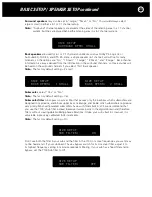
BASIC OPERATION – FREQUENTLY USED CONTROLS
AC Connection and Power
The 7100 operates on 90 – 260 volts, so no AC voltage selector switch is necessary. Plug its
power cord into an AC outlet that is always live (unswitched). The 7100 will not operate properly
if it’s plugged into an AC outlet that might be switched off. Next press the upper section of its
rear-panel
AC Power switch
. This will enable the 7100 to be turned on and off from its front-panel
Power button
or remote control
On
and
Off buttons
. The only time you might want to use the
AC Power switch
again is if you plan to be away for an extended time.
Note:
Do not turn off the AC Power switch or unplug either end of the AC cord before the 7100
has first been turned off by the remote control or the front panel
Power button
. If AC
power is removed from the 7100 before it is turned off you will lose the selections you
made during setup and you may hear some nasty thumps in your speakers.
Controls and Operation
For starters, all you need to do is turn the 7100 on and wait a few seconds for it to “boot up.”
Select an input (see below), and raise the volume to
a comfortable level. The built-in front panel display
will show which source is selected, the listening
surround mode, and the volume level. For example:
This information is typical of what is visible on the
front panel display, but you can view additional information on your video screen display (OSD) by
pushing the
STATUS button
on the remote handset. After speaker levels have been calibrated, a
volume setting of “94” will correspond to THX Reference Level.
Note:
THX Reference Level is the volume level in a typical size home theater that is equivalent
to the volume level you hear at a THX-certified commercial movie theater. Volume at “94”
will be too loud in smaller rooms; it is largely dependent on the level at which the source
material is recorded.
Front Panel Controls
Despite its versatility, the Parasound 7100 Surround Controller has only eight pushbuttons, one
knob, a headphone jack and a status display on its front panel. That’s in part because we expect
users will most often operate it by remote control and in part because many front-panel controls
do more than one thing. The operations described in this chapter can be performed easily with
the front panel or the remote control.
26
Power
Zone
Source
Exit
Menu
Surround
Volume
Select
Mute
Dim
M o d e l 7 1 0 0 S u r r o u n d C o n t r o l l e r
DVD
DOLBY D 3/2.
1
PLIIX MOVIE
VOL: 50
1. Power button
2. Remote Zone button
3. Source Select button
4. Surround Mode button
5. Volume/select knob
6. Setup Menu button
7. Menu Exit button
8. Display Dim button
9. Audio Mute button
10. Headphone jack
1
3
2
4
5
6
7
Glows Red in Standby
8
9
10
DVD
DOLBY D 3/2.
1
PLIIX MOVIE
VOL: 50
















































